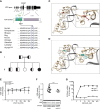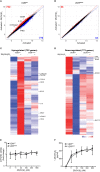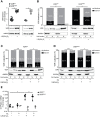Impaired Vitamin D Signaling in T Cells From a Family With Hereditary Vitamin D Resistant Rickets
- PMID: 34093587
- PMCID: PMC8170129
- DOI: 10.3389/fimmu.2021.684015
Impaired Vitamin D Signaling in T Cells From a Family With Hereditary Vitamin D Resistant Rickets
Abstract
The active form of vitamin D, 1,25-dihydroxyvitamin D3 (1,25(OH)2D3), mediates its immunomodulatory effects by binding to the vitamin D receptor (VDR). Here, we describe a new point mutation in the DNA-binding domain of the VDR and its consequences for 1,25(OH)2D3 signaling in T cells from heterozygous and homozygous carriers of the mutation. The mutation did not affect the overall structure or the ability of the VDR to bind 1,25(OH)2D3 and the retinoid X receptor. However, the subcellular localization of the VDR was strongly affected and the transcriptional activity was abolished by the mutation. In heterozygous carriers of the mutation, 1,25(OH)2D3-induced gene regulation was reduced by ~ 50% indicating that the expression level of wild-type VDR determines 1,25(OH)2D3 responsiveness in T cells. We show that vitamin D-mediated suppression of vitamin A-induced gene regulation depends on an intact ability of the VDR to bind DNA. Furthermore, we demonstrate that vitamin A inhibits 1,25(OH)2D3-induced translocation of the VDR to the nucleus and 1,25(OH)2D3-induced up-regulation of CYP24A1. Taken together, this study unravels novel aspects of vitamin D signaling and function of the VDR in human T cells.
Keywords: HVDRR; T cells; vitamin A; vitamin D; vitamin D receptor.
Copyright © 2021 Al-Jaberi, Kongsbak-Wismann, Aguayo-Orozco, Krogh, Buus, Lopez, Rode, Gravesen, Olgaard, Brunak, Woetmann, Ødum, Bonefeld and Geisler.
Conflict of interest statement
The authors declare that the research was conducted in the absence of any commercial or financial relationships that could be construed as a potential conflict of interest.
Figures





Similar articles
-
The vitamin D hormone and its nuclear receptor: molecular actions and disease states.J Endocrinol. 1997 Sep;154 Suppl:S57-73. J Endocrinol. 1997. PMID: 9379138 Review.
-
Hereditary vitamin D resistant rickets caused by a novel mutation in the vitamin D receptor that results in decreased affinity for hormone and cellular hyporesponsiveness.J Clin Invest. 1997 Jan 15;99(2):297-304. doi: 10.1172/JCI119158. J Clin Invest. 1997. PMID: 9005998 Free PMC article.
-
Hereditary vitamin D-resistant rickets (HVDRR) owing to a heterozygous mutation in the vitamin D receptor.J Bone Miner Res. 2011 Nov;26(11):2710-8. doi: 10.1002/jbmr.484. J Bone Miner Res. 2011. PMID: 21812032
-
Functional Analysis of VDR Gene Mutation R343H in A Child with Vitamin D-Resistant Rickets with Alopecia.Sci Rep. 2017 Nov 10;7(1):15337. doi: 10.1038/s41598-017-15692-z. Sci Rep. 2017. PMID: 29127362 Free PMC article.
-
Structural aspects of Vitamin D endocrinology.Mol Cell Endocrinol. 2017 Sep 15;453:22-35. doi: 10.1016/j.mce.2017.02.046. Epub 2017 Feb 28. Mol Cell Endocrinol. 2017. PMID: 28257826 Review.
Cited by
-
Reduced vitamin D-induced cathelicidin production and killing of Mycobacterium tuberculosis in macrophages from a patient with a non-functional vitamin D receptor: A case report.Front Immunol. 2022 Nov 3;13:1038960. doi: 10.3389/fimmu.2022.1038960. eCollection 2022. Front Immunol. 2022. PMID: 36405761 Free PMC article.
-
Vitamin D Inhibits IL-22 Production Through a Repressive Vitamin D Response Element in the il22 Promoter.Front Immunol. 2021 Aug 2;12:715059. doi: 10.3389/fimmu.2021.715059. eCollection 2021. Front Immunol. 2021. PMID: 34408754 Free PMC article.
-
Comparison of the role of vitamin D in normal organs and those affected by COVID-19.Int J Med Sci. 2025 Jan 1;22(2):240-251. doi: 10.7150/ijms.103260. eCollection 2025. Int J Med Sci. 2025. PMID: 39781525 Free PMC article. Review.
-
Vitamin D in Cutaneous T-Cell Lymphoma.Cells. 2024 Mar 13;13(6):503. doi: 10.3390/cells13060503. Cells. 2024. PMID: 38534347 Free PMC article. Review.
-
Role of IL-22 in homeostasis and diseases of the skin.APMIS. 2022 Jun;130(6):314-322. doi: 10.1111/apm.13221. Epub 2022 Apr 6. APMIS. 2022. PMID: 35316548 Free PMC article. Review.
References
-
- Rode AKO, Kongsbak M, Hansen MM, Lopez DV, Levring TB, Woetmann A, et al. . Vitamin D Counteracts Mycobacterium Tuberculosis-Induced Cathelicidin Downregulation in Dendritic Cells and Allows Th1 Differentiation and IFNgamma Secretion. Front Immunol (2017) 8:656. 10.3389/fimmu.2017.00656 - DOI - PMC - PubMed
Publication types
MeSH terms
Substances
LinkOut - more resources
Full Text Sources
Medical

